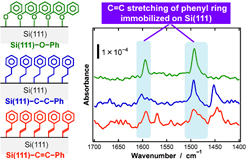Fabrication, Spectroscopic Characterization and Transport Properties of Aromatic Monolayers Covalently bonded to Si(111)
Yoshinobu Group
Fabrication of self-assembled monolayers (SAMs) of organic molecules on semiconductor surfaces is one of the central issues in surface science and device chemistry because of its ability to impart renewed functionalities on the surfaces. Since well-ordered and dense organic SAMs can be fabricated without severe reaction conditions and expensive equipment, organic SAMs on a semiconductor have become attractive materials that are easily accessible model systems for both fundamental scientific research and development of practical molecular devices. Among various semiconductor–organic interface structures, Si-organic molecule systems are promising candidates for future applications because of the actual proven performance of Si in today’s electronics.

Fig. 1. (left) Schematic representations of the aromatic monolayers on Si(111) in this study [Si(111)–O–Ph (green), Si(111)–C–C–Ph (blue), and Si(111)–C=C–Ph (red)]. (right) Transmission FT-IR spectra of these Si(111)-aromatic SAMs measured at an incident angle of 60°. Copyright © 2013 American Chemical Society.
In this study [1], SAMs composed of aromatic molecules with different anchor groups were fabricated on the Si(111) surfaces by wet chemical reactions. We investigated the bonding structures and transport properties by spectroscopic and electrical measurements, respectively. By using simple aromatic molecules (phenol, styrene, and phenylacetylene) as initial precursors, we successfully fabricated aromatic SAMs covalently bonded to Si(111) surfaces through different anchor structures (Si–O–, Si–CH2–CH2–, and Si–CH=CH−). Transmission infrared spectra clearly indicate that the phenyl rings in the SAMs are oriented almost perpendicular to the Si surfaces. High-resolution X-ray photoelectron spectra using synchrotron radiation (KEK-PF BL13) reveal that the aromatic molecules attach to the Si surface with the surface coverage of ~ 0.5. These experimental results lead to a conclusion that the aromatic SAMs form densely packed monolayers on Si(111) using the present wet chemical methods. Judging from the current density–voltage measurements of Hg/aromatic SAM–Si(111) sandwiched structures, the “Si(111)–O–Ph” (SAM by using phenol) system shows higher conductivity compared with the long-chain alkyl SAM on Si(111).
References
- [1] Y. Harada, T. Koitaya, K. Mukai, S. Yoshimoto, and J. Yoshinobu, J. Phys. Chem. C 117, 7497 (2013).
